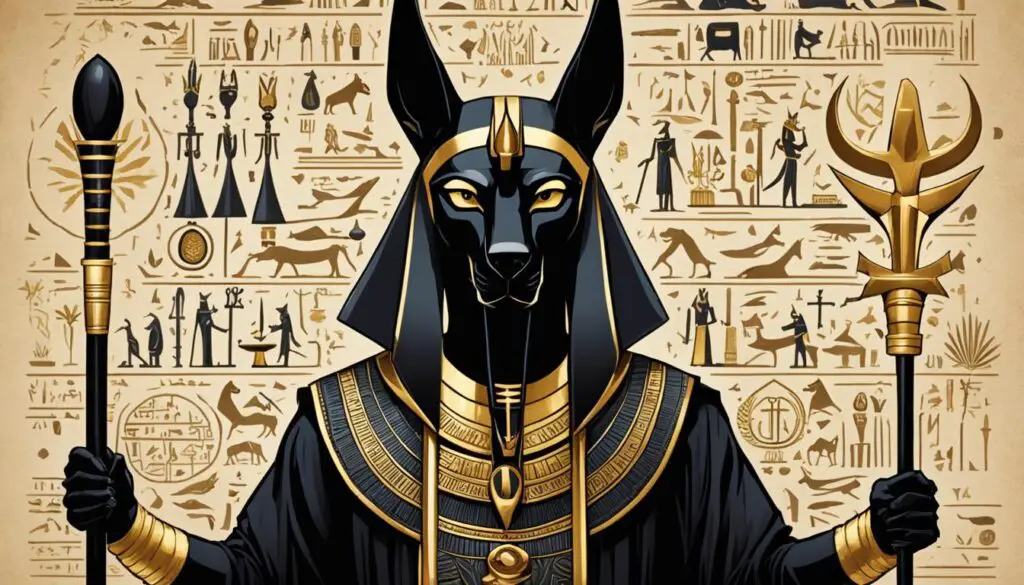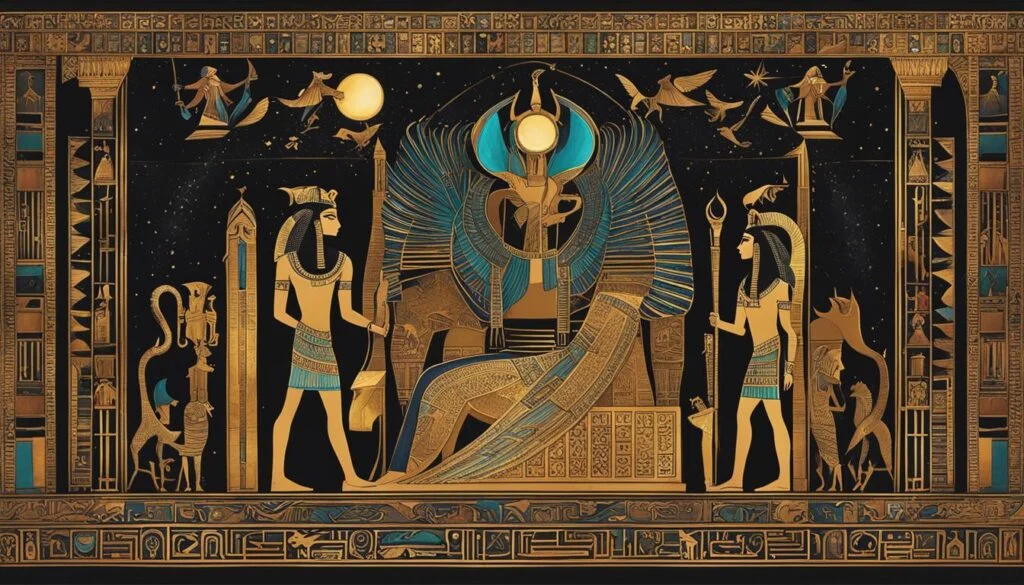Anubis, the ancient Egyptian god of death, holds a revered place in Egyptian mythology and culture. As a deity associated with the afterlife, he played a crucial role in guiding souls to their eternal resting place. However, despite his significance, Anubis remains enigmatic, with many unanswered questions surrounding his origins and symbolism.
Key Takeaways:
- Anubis, the Egyptian god of death, was a central figure in ancient Egyptian mythology and beliefs.
- His role involved guiding souls through the afterlife and weighing their hearts against the feather of Ma’at for judgment.
- Anubis is often depicted as a jackal-headed god, symbolizing his connection to death and embalming rituals.
- His worship and symbolism continue to inspire modern art, movies, and video games.
- The mysteries surrounding Anubis and his enduring legacy highlight the fascination with ancient Egyptian mythology.
Anubis Origins
Anubis, a prominent figure in Egyptian mythology, has captivated the imagination of people throughout history. Often depicted as a jackal-headed god or a man with the head of a jackal, Anubis played a crucial role in the ancient Egyptian civilization.
One of the significant responsibilities of Anubis was his involvement in the mummification process. He oversaw the preservation and preparation of the bodies of the deceased for their journey to the afterlife. Anubis was also known as the deity of mummification, ensuring that the rituals associated with this sacred practice were conducted with utmost care and precision.
One of the key aspects of Anubis’s role was weighing the hearts of the deceased against the feather of Ma’at, the goddess of truth and justice. This process, known as “weighing the hearts,” determined the fate of the souls in the afterlife. If the heart was found to be lighter than the feather, it meant that the deceased led a virtuous life and would be granted eternal bliss. On the other hand, if the heart was heavier, it indicated a life filled with wrongdoing and the soul would face punishment.
The origins of Anubis remain a subject of debate among historians and Egyptologists. Some suggest that he may have originated from local Egyptian jackal deities, while others believe he might have been influenced by the ancient god Hermanubis, a combination of the Greek god Hermes and the Egyptian god Anubis. Regardless of its origins, Anubis’s association with death, mummification, and the weighing of hearts solidifies his significance in Egyptian mythology.
Anubis Role in Egypt
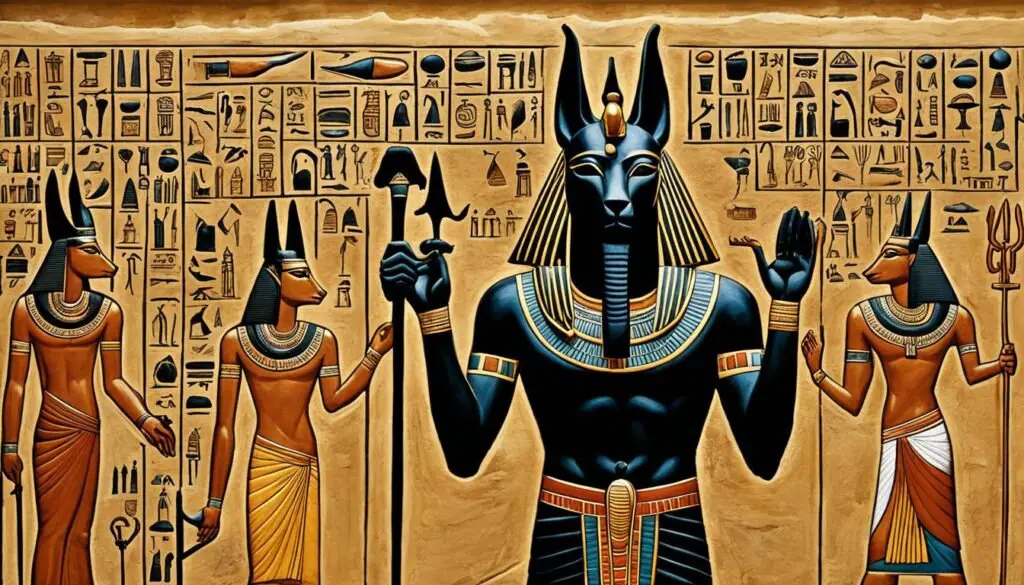
Anubis played a significant role in ancient Egyptian culture and religion. As the god of death, he held the responsibility of mummification, ensuring that the bodies of the deceased were prepared and preserved for their journey to the afterlife. This meticulous process involved removing the internal organs, treating the body with natron, and wrapping it in linen bandages.
Anubis also served as a guide for the souls of the dead. Believed to be the one who led the deceased through the treacherous underworld, he guided them towards their eternal resting place. Egyptians held the belief that Anubis protected the dead, ensuring their safe passage and acting as a guardian of their souls.
In addition to his role in death and mummification, Anubis was regarded as the gatekeeper and guide to the afterlife. Egyptians believed that he judged the hearts of the deceased, weighing them against the feather of Ma’at, the goddess of truth and justice. Only those with pure hearts, free from sin, could proceed to the realm of the afterlife. This judgment was a crucial aspect of the ancient Egyptian belief system, ensuring that the dead were justly rewarded based on their actions in life.
With his vital role in the journey to the afterlife, Anubis was a central figure in ancient Egyptian funerary rituals and cultural practices. His presence brought comfort and reassurance to the living, knowing that their deceased loved ones were under his watchful guidance and protection.
Mysteries of Anubis
As we delve deeper into the world of ancient Egyptian mythology, the enigmatic figure of Anubis presents us with numerous mysteries. Scholars and historians are still puzzled by the worship of Anubis by the ancient Egyptians, and his weaknesses remain shrouded in uncertainty. This captivating deity continues to intrigue and fascinate us, leaving us with countless questions about his significance and symbolism.
Why did the ancient Egyptians worship Anubis with such reverence? Their devotion to this jackal-headed god is a topic that perplexes even the most knowledgeable experts. Was it his role as the guardian of the dead or his association with the afterlife that earned him their adoration? The motives behind the worship of Anubis remain elusive, and we can only speculate about the deep-rooted beliefs that compelled the ancient Egyptians to venerate him.
Additionally, what were the weaknesses of Anubis? As a powerful deity closely associated with death and the afterlife, one would assume that he had invincibility. However, there may exist vulnerabilities and limitations that are yet to be unraveled. Understanding Anubis’s weaknesses could shed light on the complex nature of this deity and provide insights into the ancient Egyptians’ perception of mortality.
Despite the ongoing mysteries surrounding Anubis, one thing is certain: his role in ancient Egyptian mythology is captivating and profound. Whether it is the symbolism of the jackal-headed god or the intriguing rituals associated with him, Anubis remains an enigmatic presence that continues to pique our curiosity and fuel our fascination with the ancient world.
Modern Pop Culture Depictions
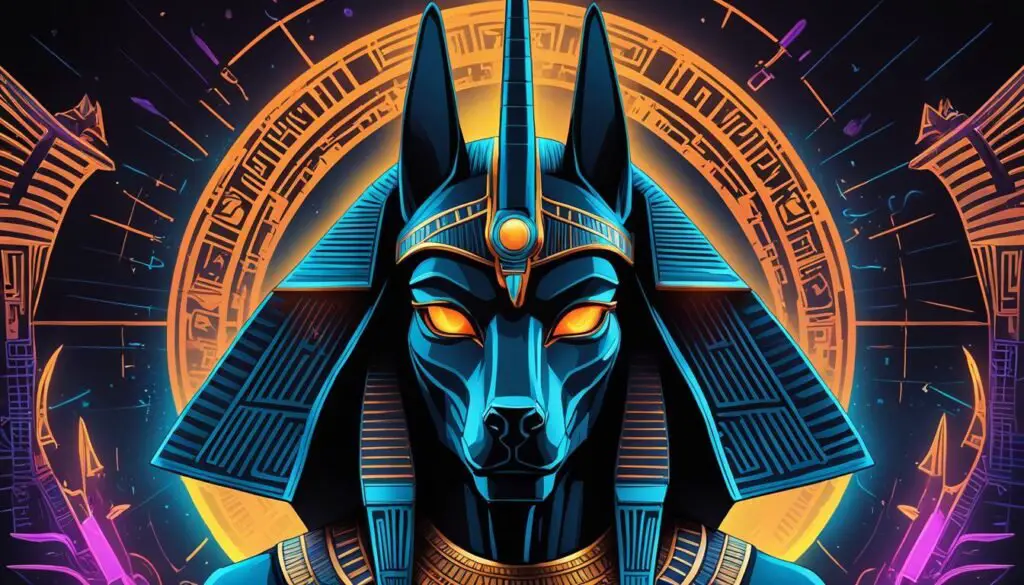
Anubis, with his captivating image and symbolism, has left an enduring imprint on popular culture. This ancient Egyptian deity has made appearances in several movies, TV shows, and video games, captivating the imaginations of modern audiences.
In the “The Mummy” franchise, Anubis is portrayed as a powerful and imposing figure, embodying the essence of death and the afterlife. His role as a guardian and ruler of the underworld showcases his authority and mystique.
Another notable portrayal of Anubis can be found in the popular TV show “American Gods”. Here, Anubis is depicted with a compassionate and merciful nature, guiding souls through the afterlife with a solemn grace.
Video games have also embraced the allure of Anubis. From ancient Egyptian-themed adventures to modern fantasy realms, Anubis has become a popular character in various gaming titles, immersing players in the rich mythology of ancient Egypt.
With each portrayal, Anubis continues to captivate audiences, evoking a sense of wonder and fascination with his enigmatic character. Whether depicted as a compassionate guide or a formidable adversary, Anubis remains an iconic figure in popular culture.
Unveiling the Female Counterpart – Anput
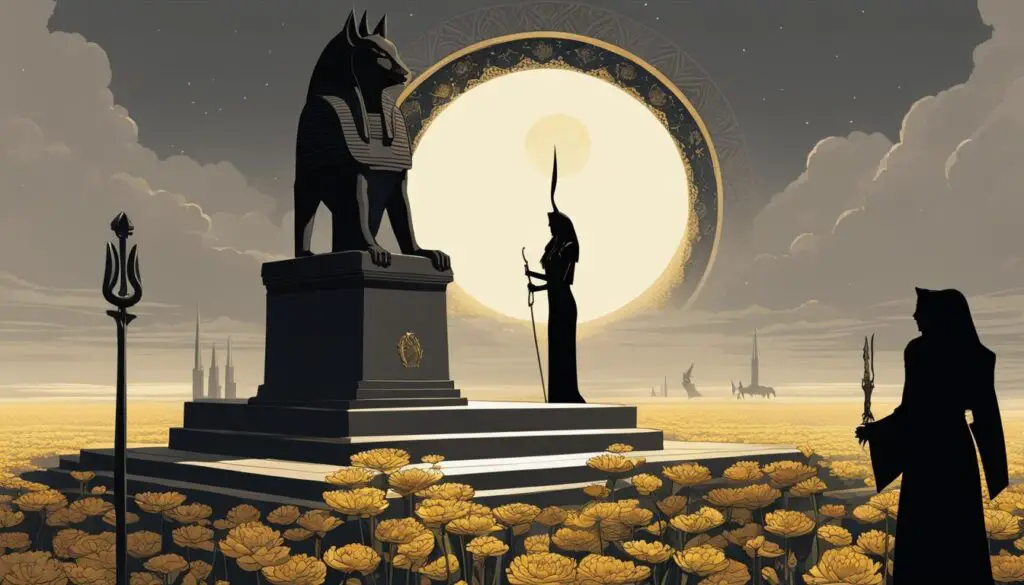
Anput, the wife and female counterpart of Anubis, is a lesser-known deity in Egyptian mythology. She plays a vital role in the sacred rituals and journey to the afterlife. Associated with mourning, protection, and the preservation of the deceased’s body, Anput is a goddess of great significance.
In ancient Egypt, Anput oversaw the embalming process, ensuring the proper preservation of the body for its journey beyond. She held a profound responsibility in guiding the soul to the afterlife, acting as a guardian and protector during this perilous transition.
Anput’s presence in the funerary rites of ancient Egypt was crucial. She played an essential role in the sacred rituals and ceremonies dedicated to honoring the departed and ensuring their safe passage to the afterlife. Her influence was profound, bringing solace to the mourners and comfort to the departed.
While Anubis often takes the spotlight in discussions about ancient Egyptian mythology, Anput’s significant role shouldn’t be underestimated. As the female counterpart and companion of Anubis, she complements and balances his attributes, showcasing the duality within the realms of death and mourning.
Anput’s prominence may have faded over the centuries, but her symbolism and importance endure. She is an integral part of the Egyptian pantheon, representing the delicate yet essential aspects of grieving, protection, and guiding souls on their eternal journey.
The Role of Anput in Ancient Egyptian Mythology
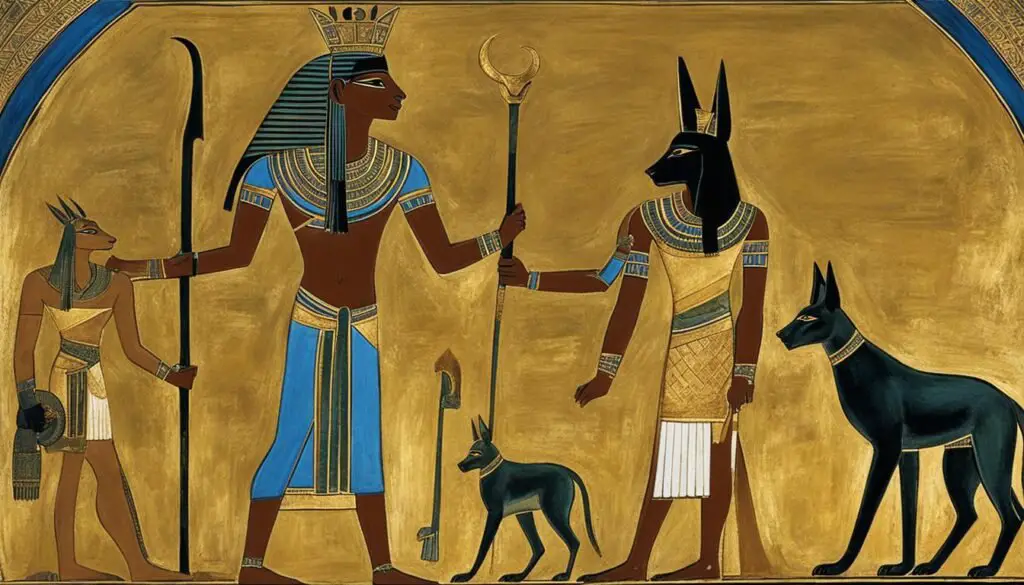
In ancient Egyptian mythology, Anput played a vital role as the protector and guardian of the deceased. Believed to guide the souls of the departed through the treacherous journey of the underworld, Anput ensured their safe passage to the afterlife. As a deity associated with protection, she watched over the souls and provided them with the necessary guidance and shelter.
Anput’s role extended beyond spiritual guidance as she also had a connection to the embalming process. Egyptians invoked her presence to ensure the proper preservation of the deceased’s body, preparing it for the journey beyond. With her watchful eye, Anput safeguarded the physical vessel, allowing it to reach its final destination intact.
The reverence for Anput as the guardian of the deceased highlights the importance of the afterlife in ancient Egyptian culture. Her role in ensuring protection and preservation reflects the profound beliefs and rituals surrounding death and the journey to eternity in Egyptian mythology.
Symbolism and Depictions of Anput
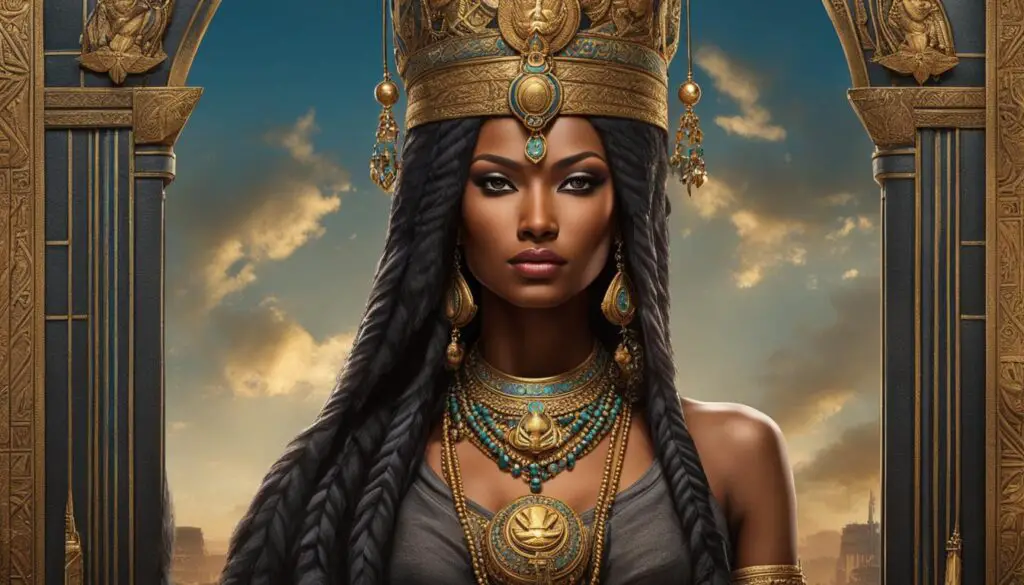
Anput, like Anubis, is often depicted as a jackal-headed goddess, symbolizing her connection to death and the afterlife. She embodies the essence of mourning and is associated with the rituals and ceremonies dedicated to the deceased. Anput’s presence as a guardian and protector is represented in ancient Egyptian art and symbolism.
In ancient Egyptian culture, the jackal was seen as a powerful symbol of death and the supernatural. Anput’s depiction as a jackal-headed goddess reflects her role as a guardian of souls and keeper of the underworld. Her image conveys both the ethereal beauty and the strength required to guide the departed on their journey to the afterlife.
As the embodiment of mourning and protection, Anput was often invoked during funerary rituals and ceremonies. Egyptians believed that she watched over the deceased and ensured their safe passage to the realm of the afterlife. Her presence provided comfort and solace to those grieving the loss of loved ones.
Ancient Egyptian art often depicts Anput alongside Anubis, emphasizing their interconnected roles as guardians and guides in the realm of the dead. As partners, they worked in harmony to safeguard the souls of the departed and ensure their eternal rest. Their combined symbolism and influence continue to captivate and inspire awe to this day.
The Enduring Legacy of Anubis and Anput
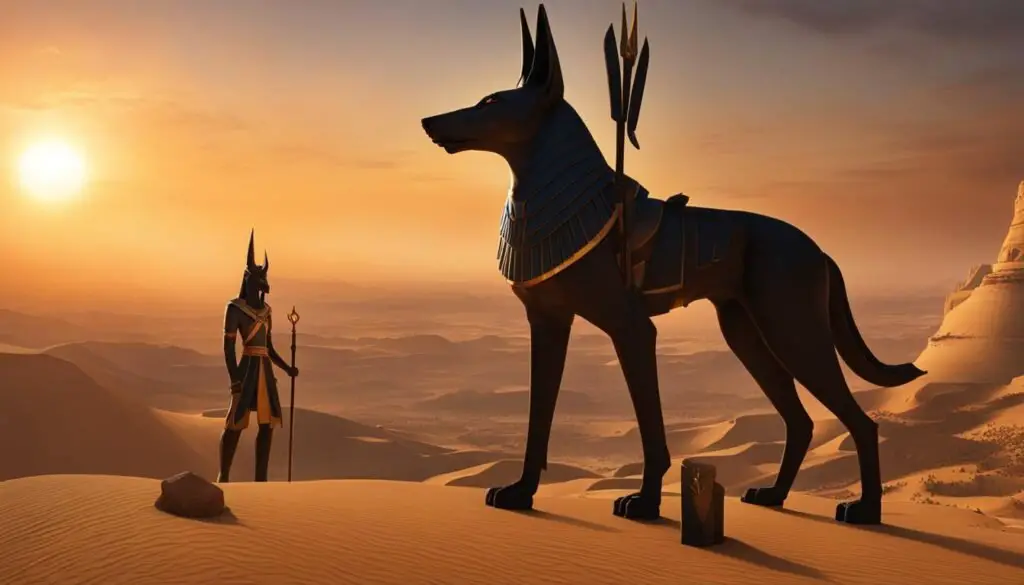
The legacies of Anubis and Anput continue to captivate modern audiences and inspire artistic representations. These ancient Egyptian deities hold a significant place in the enduring legacy of ancient Egyptian mythology.
Anubis, the god of death and mummification, represents the profound spiritual beliefs and practices of ancient Egyptian culture. His role as a guide and guardian in the afterlife has left an indelible mark on popular culture, with representations in movies, TV shows, and other forms of media.
Similarly, Anput, the wife and female counterpart of Anubis, embodies the essence of mourning and protection. Her presence as a guardian and protector of the deceased, guiding souls through the perilous journey of the underworld, contributes to the enduring fascination of ancient Egyptian beliefs.
The enduring legacy of Anubis and Anput showcases the timeless allure of ancient Egyptian mythology. Their representation in popular culture serves as a testament to the enduring fascination with life, death, and the supernatural.
- Their roles as guides and guardians in the afterlife
- The representation of ancient Egyptian culture in popular media
- The continued curiosity surrounding the mysteries of life, death, and the supernatural
The enduring legacy of Anubis and Anput reminds us of the rich and profound significance of ancient Egyptian mythology in today’s world.
Conclusion
Anubis and Anput, the enigmatic figures of Egyptian mythology, hold a significant place in the ancient belief system. As the god of death and the goddess of mourning, they embody the duality of life and death, guiding souls through the afterlife and ensuring the preservation of the deceased.
Despite the mysteries surrounding their origins and existence, the fascination with Anubis and Anput remains enduring. Their roles in popular culture, from movies to video games, speak to the timeless allure of ancient Egyptian mythology, captivating modern audiences with their symbolism and representations.
Through the worship of Anubis and the presence of Anput, ancient Egyptians found solace in the understanding of life’s transience and the journey that awaits in the afterlife. Even today, these extraordinary deities continue to inspire curiosity and spark exploration into the rich mythological traditions of ancient Egypt.
FAQ
Who is Anubis?
Anubis is an ancient Egyptian god of death and mummification. He is often depicted as a jackal-headed god or a man with the head of a jackal.
What was Anubis’ role in ancient Egyptian mythology?
Anubis played a crucial role in Egyptian mummification rituals and was responsible for weighing the hearts of the deceased against the feather of Ma’at, the goddess of truth and justice. He also acted as a guide for the souls of the dead, ensuring their safe passage to the afterlife.
What are some mysteries surrounding Anubis?
The reasons behind the worship of Anubis by ancient Egyptians and his weaknesses remain a mystery to scholars.
How is Anubis portrayed in popular culture?
Anubis has been portrayed in various movies, TV shows, and video games, with depictions varying from a merciful ruler of the underworld to a powerful antagonist.
Who is Anput?
Anput is the wife and female counterpart of Anubis. She is associated with mourning, protection, and the preservation of the deceased’s body.
What was Anput’s role in ancient Egyptian mythology?
Anput protected and guided the souls of the departed through the journey of the underworld and ensured the preservation of their bodies for the afterlife.
How is Anput depicted in ancient Egyptian art?
Anput is often depicted as a jackal-headed goddess, symbolizing her connection to death and the afterlife. She embodies the essence of mourning and is associated with the rituals and ceremonies dedicated to the deceased.
What is the enduring legacy of Anubis and Anput?
Both Anubis and Anput continue to captivate modern audiences and inspire artistic representations. Their roles as guides and guardians in the afterlife reflect the profound spiritual beliefs and practices of ancient Egyptian culture.


